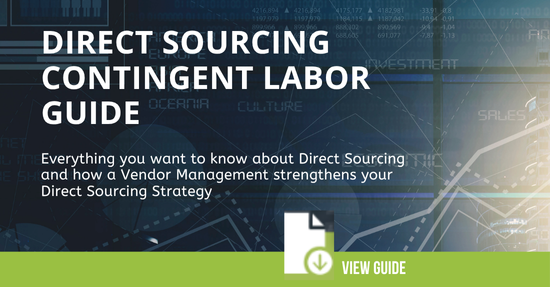As more businesses leverage the contingent workforce to enhance their talent acquisition, how can organizations boost their competitiveness in engaging these workers? In this article, we offer 5 tips for retaining contingent workers when using a Direct Sourcing program.
How do you improve how you retain contingent workers?
If you are sourcing contingent workers through staffing agencies, forging long-term relationships with contingent workers can create co-employment and legal risks. That’s because the employee-employer relationship is between the contingent worker and the staffing agency.
However, if you are contracting with contingent workers through a direct sourcing model, then maintaining a relationship is possible - although care must be taken to ensure that any risk of misclassification is mitigated.
When you find a great contingent worker who understands your requirements and delivers the work you need, then it’s only natural that you want to keep them around.
5 Ways to retain Contingent Workers that are sourced from Direct Sourcing
As you develop your Direct Sourcing Strategy, here are five tips to retaining contingent workers with care, as long as they are sourced directly and not through a staffing agency.
1 - Don't treat contingent workers like a commodity
Freelancers, independent contractors and consultants want to be an asset to the businesses they work for, but they also want to be valued and respected for the skills and talent they bring to the table.
The problem is that many businesses view contingent workers as easily replaceable, especially as the market for contingent workers grows. This translates into how those businesses deal with their contingent workers, which can lead to non-employees feeling like a commodity.
To retain your top contingent workers, you need to show them you really do appreciate them and their skills. This means paying them fairly and respecting their time. If you’re calling them in for a project, you need to provide realistic expectations, not oversell opportunities and try to avoid dropping freelancers suddenly because priorities changed. And while getting a good deal is good business practice, you don’t want to give up quality and dependability for a few extra bucks. Be sure to research going rates for the type of work you require a contingent worker for, and be fair.
2 - Provide a consistent flow of interesting work
If you keep your contingent workers busy, they won’t need to think about going elsewhere. This means you need to have a regular flow of work heading their way.
To ensure you don’t lose visibility of your contingent workers and what work you are sending their way, make sure to use a vendor management system (VMS). A VMS helps you track all of your non-employee workers and automate the processes associated with managing them, such as onboarding, or invoicing and payments.
3 - Increase roles and responsibilities
Nobody wants to get stuck doing the same thing every day for the rest of their lives. This is especially true for contingent workers, and is one of the many reasons why they turn to contingent work - for variety. When you can, find new projects that they may be interested in. To make this easier, get in touch with your contingent workers and find out what other jobs they would be interested in or other skills they may have.
4 - Keep in touch
For some contingent workers, such as freelancers, independent contractors or consultants, they have the luxury of being able to choose when they work and where from. This doesn’t mean you shouldn’t set up strong methods of communication and collaboration with them. Contingent workers still want to be strongly involved in the project they are working on.
An open line of communication will help them feel more connected to the business, increasing loyalty and can help them produce even better work. It also ensures they won’t be forgotten when there are big changes, whether it be new products, branding or something else that will affect the work they do for you.
5 - Show an interest
Go beyond just keeping in touch about work related topics. Take the time to get to know your contingent workers. This creates a personal bond that can help build mutual respect. You don’t want to get too personal, but if they happen to mention an interest or event in their life, make a note to check back in and ask about their progress.
Final Thoughts
At the end of the day, your contingent workforce is just that – your workforce. They are there to help your business grow. But going the extra mile to make them feel like a real person who you respect and trust can really help increase their loyalty to your business and the effort they put into their work.
After-all, contingent workers depend on you as much as you depend on them.
One important factor when managing directly sourced contingent workers is to take care of maintaining these relationships, while at the same time mitigating any co-employment and misclassification risks. Misclassifying workers as contingent instead of as employees can result in hefty fines and lawsuits aimed at your organization. To mitigate these risks, ensure your business has tenure policies, proper contractual arrangements and robust documentation in place to ensure you’re managing these workers legally.
Learn More about Direct Sourcing
Check out our Direct Sourcing Guide to learn more about Direct Sourcing, its benefits and how a Vendor Management System strengthens a Direct Sourcing Strategy: View Direct Sourcing Guide
Discover the Power of Conexis VMS for Direct Sourcing
Conexis is an award-winning Vendor Management System built for organizations that want the power of enterprise software without the complexity or cost.
Leveraging the latest technology, Conexis delivers the expertise, reliability, and security of enterprise systems, while offering the flexibility, user friendliness and tailored, personal service you require. Learn more about our Company and why organizations Choose Conexis VMS.
Additional Articles on this Topic:
- Direct Sourcing: What is it?
- Direct Souring vs. Traditional Staffing Models
- 5 Benefits of Direct Sourcing
- 5 Direct Sourcing Retention Tips for Contingent Labor
- Building a Direct Sourcing Strategy
- Why a Vendor Management System is Essential for a Direct Sourcing Program






